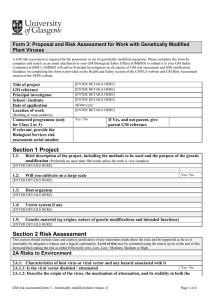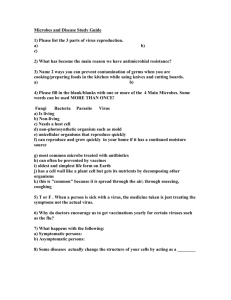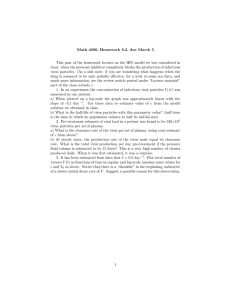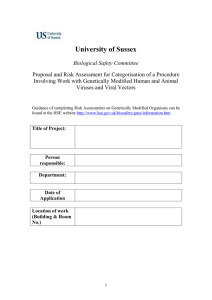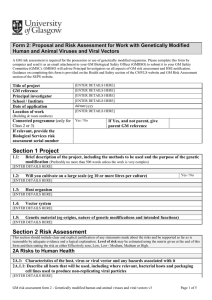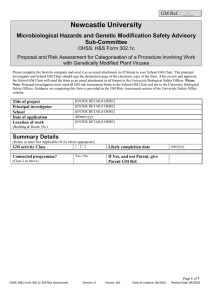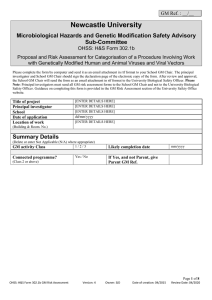Plant Viruses Form
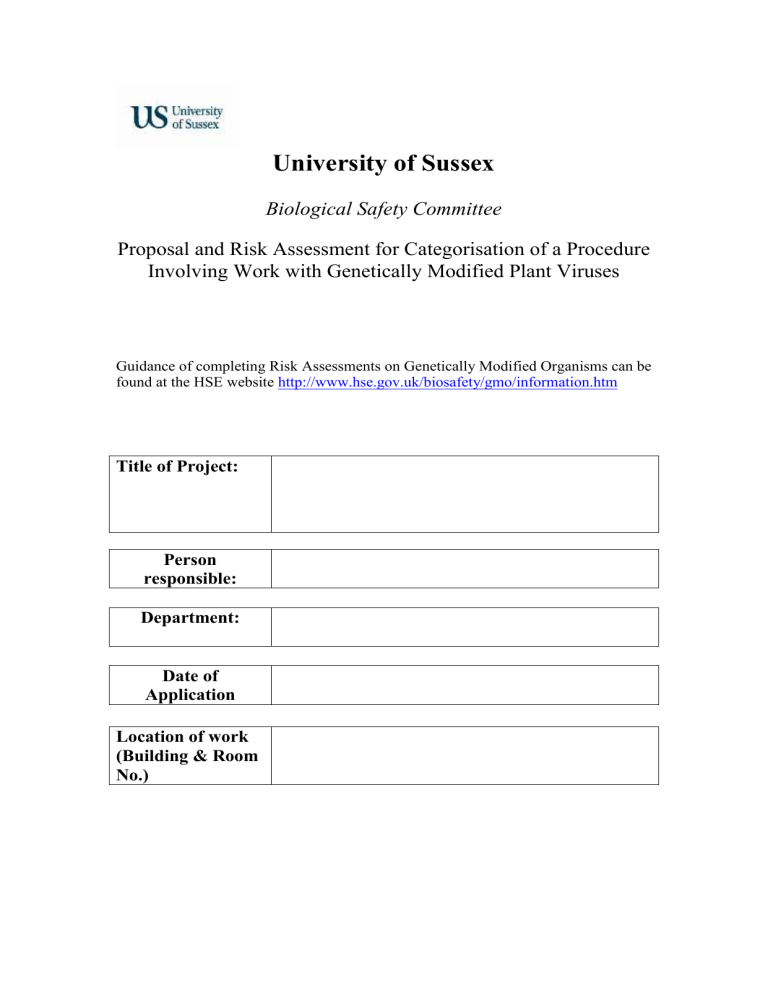
University of Sussex
Biological Safety Committee
Proposal and Risk Assessment for Categorisation of a Procedure
Involving Work with Genetically Modified Plant Viruses
Guidance of completing Risk Assessments on Genetically Modified Organisms can be found at the HSE website http://www.hse.gov.uk/biosafety/gmo/information.htm
Title of Project:
Person responsible:
Department:
Date of
Application
Location of work
(Building & Room
No.)
Section 1 Personnel
Briefly indicate your experience of working with microorganisms and genetically manipulated organisms and any training you have received
Other workers on the project [if known]
Qualifications Experience/Training
2
Section 2 Project
Description of the project, including the methods to be used and the purpose of the genetic modification
Will you cultivate on a large scale (e.g. 10 or more litres per culture)? Yes/No
Host organism
Vector system
Origins and intended function of the genetic material involved
3
Section 3: Risk Assessment
Section 3A: Assessment for Environmental Harm
NB : This section should include sufficient detail to support the justifications for any assessments made. Particular care should be taken to the assessment of work with viruses that infect plants indigenous to the UK.
Characteristics of the host virus or viral vector and any hazards associated with it
Is the viral vector disabled? If so, how?
Yes/No
Describe the origin of the virus, the mechanism of attenuation, and its stability in both the parent viral vector and the recombinant vector
Indicate the probability of reversion to the wildtype
Is the viral vector replication competent?
Are all potential routes of transmission of the virus known, e.g. those that may occur during a laboratory accident?
If yes, will the routes of transmission deliver the virus or its products to tissues where it may be biologically active?
Is there potential for the transmission of the naked nucleic acid?
Yes/No
Yes/No
Yes/No
Yes/No
4
Source and characteristics of the inserted gene product and any hazards arising directly from its use
Describe the nature of the inserted genes and the properties of the final genetically modified viral vector
Does the insert code for a protein with known or suspected, pathological effect?
Is there reason to suspect that the tissue tropism or host range of the recombinant virus will be any different from that of the parent vector or virus?
Yes/No
Yes/No
Level of Risk:
Hazards arising from the alteration of existing pathogenic traits
Is there reason to suspect that the tissue tropism or host range of the recombinant virus will be any different from that of the parent vector or virus?
Is there reason to suspect that the modified virus may have altered susceptibility to host defence mechanisms?
Could the route of transmission of the recombinant virus be altered?
If so, what are the predicted effects of the recombinant viruses in tissues which it would not normally infect?
Level of Risk:
Yes/No
Yes/No
Yes/No
5
What is the capacity of the GMM to survive, establish, disseminate with and/or displace other organisms?
Is there reason to suspect that the recombinant virus may have enhanced environmental survival factors; e.g. enhanced tolerance to UV, temperature, desiccation etc?
Yes/No
Are all potential routes of transmission or escape of the virus to the environment known e.g. following a laboratory accident?
If yes, will the recombinant virus or its products gain access to organisms in which effects may be manifested?
Yes/No
Yes/No
Will the gene insertion affect the fitness of the virus?
Is there a potential for transmission in the form of infectious nucleic acid? Yes/No
What is the ease by which mechanical transmission of the recombinant virus may occur?
Level of risk:
What is the potential for transfer of genetic material between the GMM and other organisms?
Level of risk:
What is the likelihood that the GMM could cause harm in the event of environmental exposure?
Is the host pathogenic?
Does the insert code for a protein with known or suspected inhibitory, detrimental, or other physiologically active effect on any organisms?
Is there a potential for harmful effects of gene expression on other organisms?
Will viral susceptibility to control agents be affected by genetic modification?
Level of Risk:
Yes/No
Yes/No
Yes/No
6
Assign the provisional containment level
1 2 3 4
(Circle as appropriate)
Section 3B: Risk to Human Health
What is the likelihood that, in the event of exposure, the GM virus could cause harm to human health
E.g. By production of toxins, allergens, pharmacological or immunologically active substances.
Level of Risk:
Section 3C Final Activity Class
Assign the final activity class:
1 2 3 4
(Circle as appropriate)
7
Section 4 Control Measures Monitoring, and Inactivation
Provide details of the control measures to be used to protect human health and the environment and the means by which their use and effectiveness will be monitored. This must include details of the inactivation procedures to be employed for waste contaminated with GMMs , the expected degree of kill and any appropriate validation procedures.
Section 5: Emergency Planning
Does your departmental safety plan provide adequate protection and provision for emergency action in case of accidental release?
If no, give details of specific extra safety measures which will be applied to the project.
Yes / No
8
Departmental Signatures
Signed: ..............................................
(Supervisor of work)
Signed: ..............................................
(Departmental Biological Safety Officer)
Signed: ..............................................
(Head of Department)
Approval for the project
Signed: ..............................................
(Chair of the Biological Safety Committee)
Date…………….
Date:....................
Date:....................
Laboratory inspected and approved to be operating at the containment level required
Signed: ..............................................
(Departmental Biological Safety Officer)
Date:....................
Date:....................
9
Appendix 1: Matrix for estimation of level of risk
[Consequence x likelihood = risk of causing harm
High
Likelihood of Hazard
Medium Low Consequence of Hazard
Severe High High
Medium
Low
Negligible
High
Medium/Low Low
Effectively
Zero
Medium
Effectively
Zero
Negligible
Medium Effectively
Zero
Medium/Low Effectively
Zero
Low Effectively
Zero
Effectively
Zero
Effectively
Zero
10
